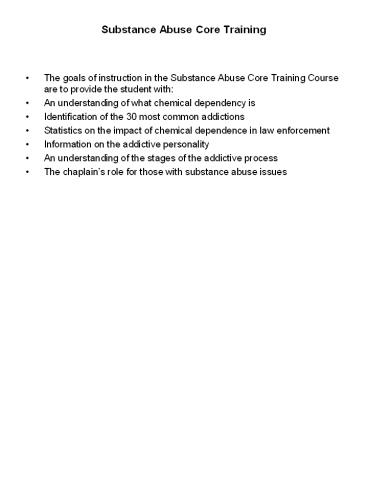Substance Abuse Core Training - PowerPoint PPT Presentation
Title:
Substance Abuse Core Training
Description:
Substance Abuse Core Training The goals of instruction in the Substance Abuse Core Training Course are to provide the student with: An understanding of what chemical ... – PowerPoint PPT presentation
Number of Views:207
Avg rating:3.0/5.0
Title: Substance Abuse Core Training
1
Substance Abuse Core Training
- The goals of instruction in the Substance Abuse
Core Training Course are to provide the student
with - An understanding of what chemical dependency is
- Identification of the 30 most common addictions
- Statistics on the impact of chemical dependence
in law enforcement - Information on the addictive personality
- An understanding of the stages of the addictive
process - The chaplains role for those with substance
abuse issues
2
Definitions Substance Abuse Core
Training Addicted The quality or condition of
being addicted to a habit-forming
substance. Addiction To cause to become
psychologically or physiologically dependent on
a habitual forming substance. Chemical
Dependency A psychological and physiological
habituation to a mood or mind-altering drug.
3
Thirty Most Common Addictions Substance Abuse
Core Training
ALCOHOL FIGHTS SEX
CAFFEINE GAMBLING SEXUAL ABUSE
THE CHASE LOVE SHOPPING
CHRONIC ILLNESS MALE DEPENDENCY SOAP OPERAS
COMPULSIVE LYING MONEY SUGAR
CHURCH NICOTINE TALKING
CREDIT CARDS OVER EATING TELEPHONE
OTHER DRUGS PAIN TELEVISION
EMOTIONAL ABUSE PHYSICAL ABUSE VIDEO GAMES
FEMALE DEPENDENCY PRESCRIPTION MEDS WORK
4
- Statistics
- Substance Abuse Core Training
- General
- Each year, drug abuse kills about
Americans and costs taxpayers nearly
. - Overall drug use in the U.S. has fallen in half
in the last 20 years. - Illicit drug use among teenagers has remained
stable for the last two years in a row, and even
decreased in some cases. - Per year use of illicit drugs among 8th and 10th
grades decreased. - Research shows that for every 1 spent on drug
abuse prevention, communities can save 4-5 in
costs for drug abuse treatment and counseling. - of adults have tried alcohol at
least once. - million teens have tried alcohol.
- Alcohol is the most popular drug of abuse--
of the drug addiction problems in the U.S. - Between 10-15 million people in the U.S. are
estimated to be alcoholics. - The majority of alcoholics are .
- of all suicides in the U.S. are related
to alcohol dependency - Law Enforcement
5
The Addictive Personality Substance Abuse Core
Training
- Four natural forms of relationship
- Relationship with the .
- An intimate caring relationship with
. - A meaningful relationship.
- The relationship with the
around us.
6
Stages of Addictive Process in the DevelopmentOf
the Addictive Personality Substance Abuse Core
Training
- Stage One
- Internal Change Stage
- - Person experiences mood changes
- - Addicts seek out relief from problems by
turning to the object of their addiction - Negative Conversion Experience
- - Pleasure from the mood change becomes all
important - - Addicts use abnormal form of relationship to
deal with human issues - - With each act of self-betrayal, self-respect,
and self-confidence start to diminish - Addictive Narcissism Addicts feel different
when they are in their addictive side - Addictive Ritual
- - The self starts to fight the addict
- - Recovery is based on surrendering to ones
addiction - - The addictive personality becomes the primary
personality that interacts with the outside
world
7
Stages of Addictive Process in the DevelopmentOf
the Addictive Personality Substance Abuse Core
Training
- Stage Three
- Life Breakdown Stage
- Addict experiences internal pain and deep
depression - Addicts feel out of control and their fears
grow - Sincere Delusion
- Thinking patterns break down, one cannot tell
what reality is any - more
- Suicide for many addicts is an act of homicide
against the addict - Most addicts stay in Stage Three until
intervention - Recovery allows person to take oppressive
nature of addiction - and turn it into a healing energy
- Recovery is joining the human community
- Recovery Has Two Major Goals
- Sobriety
- A positive conversion experience
8
Chaplains Role and Responsibilities Substance
Abuse Core Training
- Absolute confidentiality
- Intervention before the addiction becomes a
problem - Chaplains role is advocacy
- Develop network of resources

